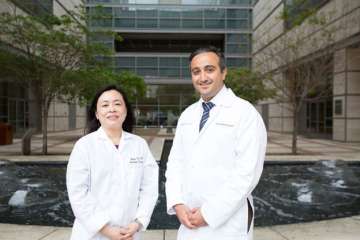Diseases and Conditions
Find your care
Call 310-825-5111 to learn more about our world-class pediatric neurosurgery services.
Special Considerations
In this section: Tuberous Sclerosis Complex | Focal Cortical Dysplasia | Hemimegalencephaly | Rasmussen’s Encephalitis | Sturge-Weber Syndrome
Epilepsy surgery for Tuberous Sclerosis Complex at UCLA
We have world-class expertise in the treatment of drug-resistant epilepsy in the setting of Tuberous Sclerosis Complex. We are also an active member of the Tuberous Sclerosis Alliance and have a designated clinic that is under the directorship of Dr. Joyce Wu.
Watch Video: Surgical Treatment of Epilepsy in Children with Tuberous Sclerosis
Tuberous Sclerosis Complex is a genetic condition that results in tuber formation throughout the brain. About 90% of these children are affected by infantile spasms or seizures, most often beginning in infancy. Medications alone are successful at controlling seizures in modest percentage of children. In the 50-80% of children that continue to have seizures despite medical therapy, other options including the ketogenic diet and vagal nerve stimulator may be available.

These are good options to consider in order to lower the frequency and severity of seizures if the child is not a candidate for a resective brain surgery. There is a positive correlation between frequency and duration of uncontrolled seizures with the development and severity of developmental delay.
In appropriately selected candidates, when seizures can be localized to one or more of these tubers, surgery can be very successful in stopping seizures completely. Advances in neuroimaging and invasive monitoring in select cases are useful methods in identifying epileptogenic tubers in these children. A multicenter international study performed by Dr. Aria Fallah and colleagues demonstrated that full resection of the tuber as well as the surrounding abnormal cortex can yield the highest rates of seizure freedom. Resection of the tuber-only is associated with a greater rate of surgical failure. We have had great success in curing seizures associated with Tuberous Sclerosis through a single stage operation.
The goal of surgical treatment is complete seizure control with minimal or no side effects. Given Tuberous Sclerosis Complex is a rare condition and it often challenging to accurately identify the epileptogenic tuber(s), it is recommended that surgery performed at an experienced center. Other organs such as the heart and kidneys can be affected in this condition so a presurgical clearance is often necessary to ensure the child doesn’t experience any deleterious risks from the anesthetic and surgery.
Special Considerations: Epilepsy Surgery
Tuberous Sclerosis Complex
Epilepsy surgery for Tuberous Sclerosis Complex
Focal Cortical Dysplasia
Epilepsy surgery for Focal Cortical Dysplasia
Rasmussen’s Encephalitis
Epilepsy surgery for Rasmussen’s Encephalitis
Hemimegalencephaly
Epilepsy surgery for Hemimegalencephaly